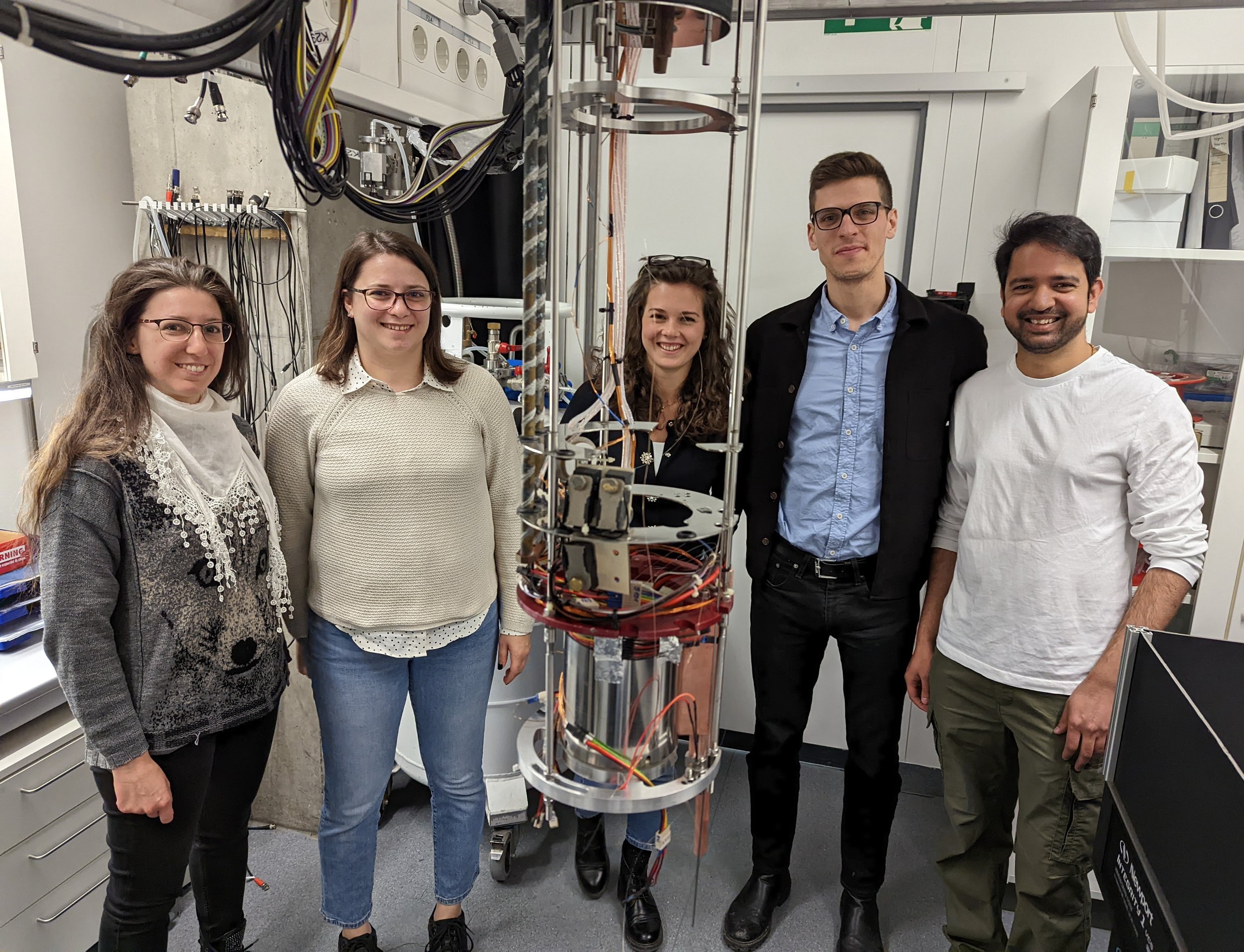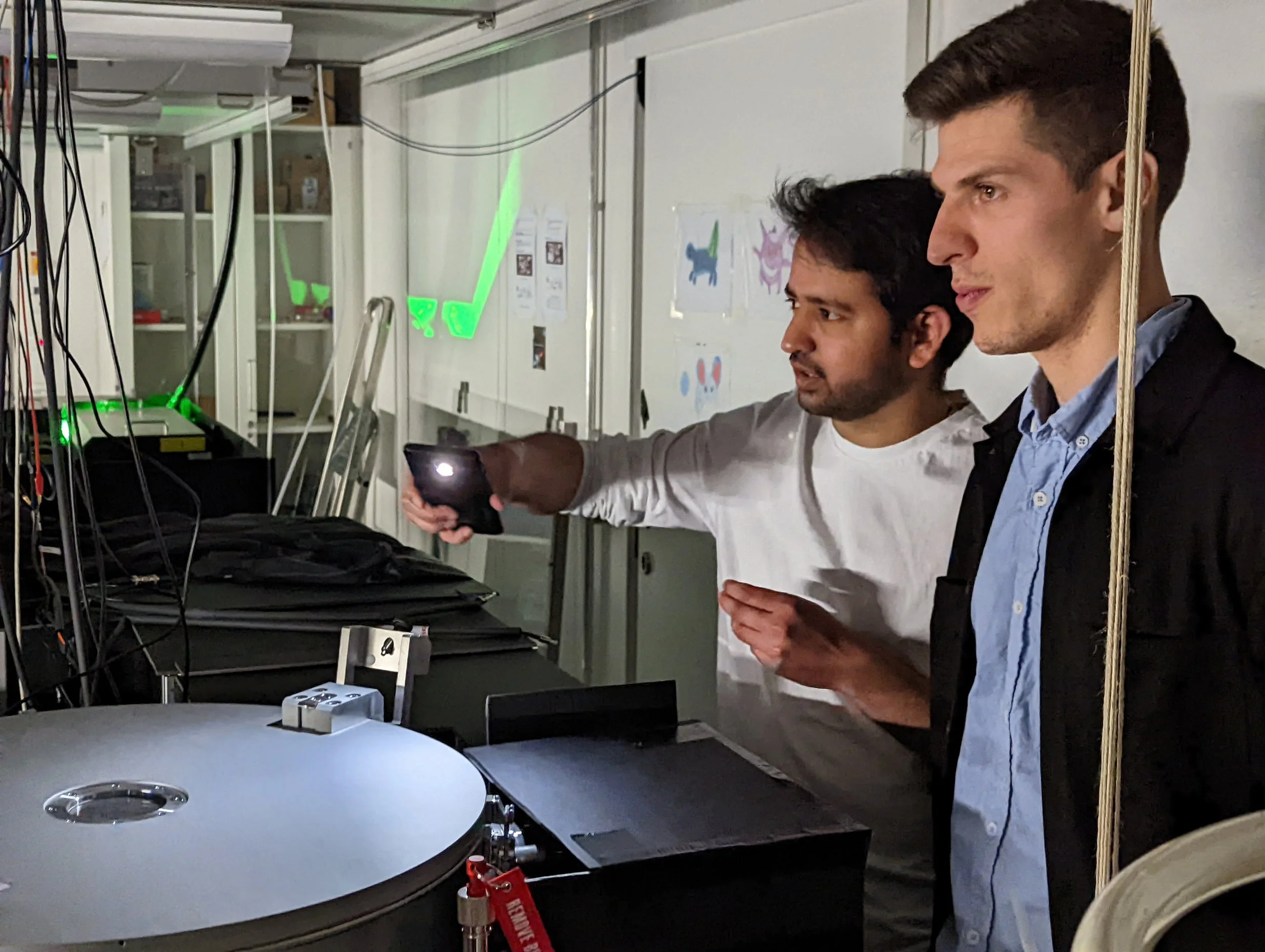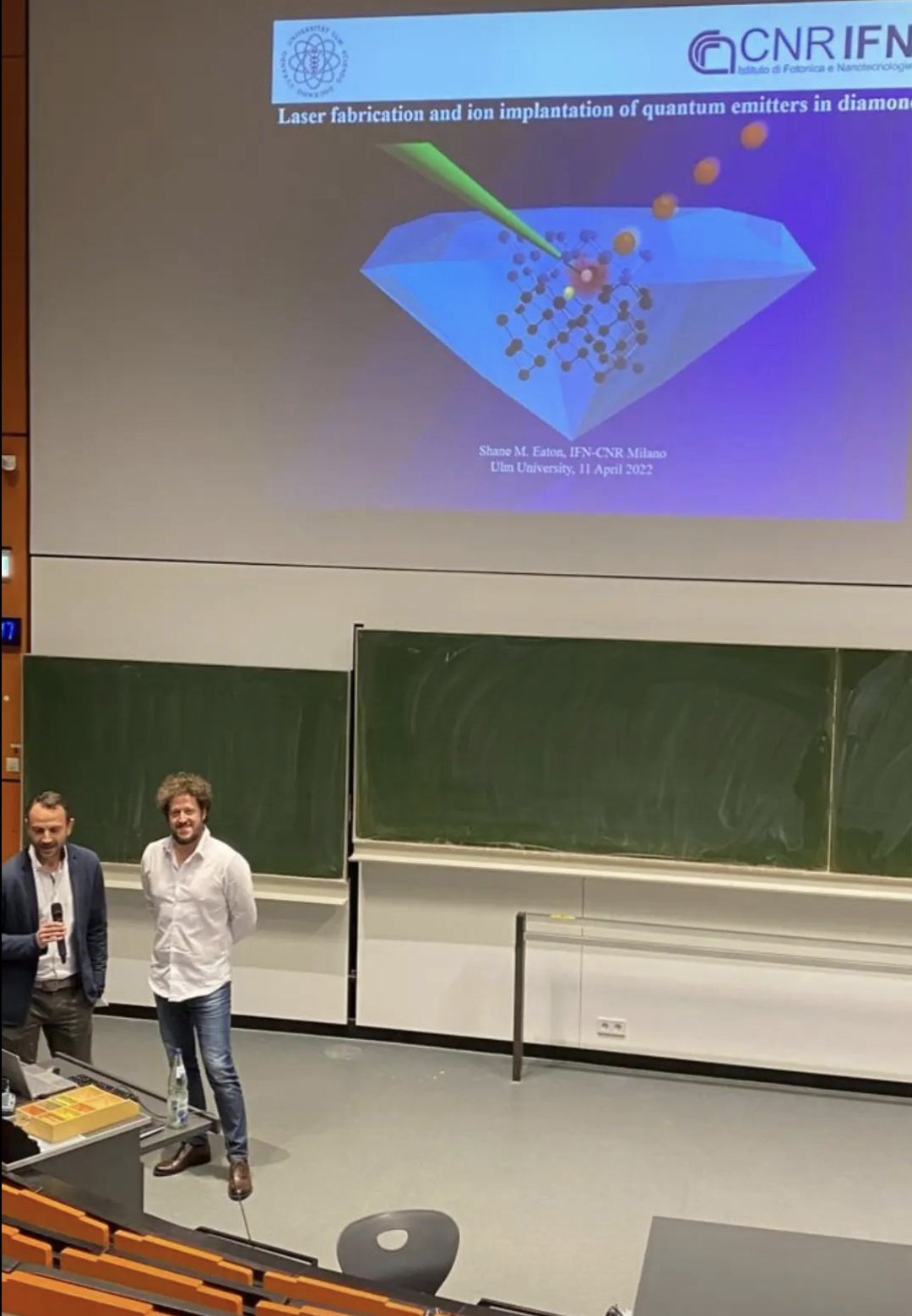Secondments
Adam Britel (UNITO) at IFN from 23 October to 3 November, 27 November to 1 December 2023
Adam Britel carried out his final secondment at INF-CNR under the guidance of Dr. Ottavia Jedrkiewicz. During his secondment at the University of Insubria, which spanned two distinct periods from October 23 to November 3, and November 27 to December 1, 2023, Adam engaged in research aimed at integrating Bessel beam induced electrodes with ion beam induced electrodes. The initial phase of this secondment focused on combining these two electrode types, facilitating the fabrication of complex 3D conductive structures with diamond. The objective was to explore the feasibility of connecting these electrodes.
The latter stage of the secondment concentrated on understanding the interactions at the intersection area between these two types of electrodes using MicroRaman analysis. This involved conducting experiments with various Bessel beam induced electrodes, modifying optical parameters to gauge their effects on the electrodes’ interplay.
Adam Britel at IFN (Como)
Diana Kafizova (ELVESYS) at IFN from 2 October to 3 November 2023
The first secondment of ESR-9, Diana Kafizova was carried out at IFN-CNR Diana worked as a part of the research team in a laser laboratory under the guidance of Dr. Shane Eaton, and Dr. Ottavia Jedrkiewicz. During this period, she was introduced to the femtosecond laser fabrication method and the procedure of laser alignment and focusing on a diamond. She used sophisticated laser operation systems together with various alignment tools and measurement devices. The research activities focused on laser fabrication carried out alongside ESR-1 and ESR-2 have helped Diana to acquire deeper theoretical knowledge and exceptional hands-on experience in optics, laser fabrication, and quantum photonics. The activities carried out in Politecnico di Milano include the fabrication of waveguides and NV color centers in diamond samples using femtosecond laser emission and the characterization of fabricated color centers and waveguides using the optical microscope. She conducted femtosecond laser writing to examine how variations in laser power (100-250 mW) affect changes in surface morphology of the sample. The activities carried out in the University of Insubria as the second part of the first secondment were focused on the fabrication of Bessel beam-induced microelectrodes in diamond samples using different parameters of laser such as energy, pulse duration, power, and the number of pulses. The effect of various laser parameters on the fabricated electrode was studied. Diana learned sample alignment, laser focusing, and characterization in both institutions. Through this secondment, Diana was able to obtain profound knowledge and skills both theoretical and practical in femtosecond laser fabrication on diamond and its application in microfluidics, quantum photonics, and sensing. The experience she gained in this secondment can potentially help to fabricate and characterize microfluidic channels in diamond samples in the future and open new opportunities in the integration of laser-induced quantum sensors in microfluidic chips.
ESR9 Diana aligning Bessel beam laser microfabrication system at IFN (Como)
ESR9 Diana aligning Gaussian beam laser microfabrication system at IFN (Lecco)
Giulio Coccia (IFN) at Cardiff University (CU) from 11 June 2023 to 28 July 2023
Giulio Coccia (ESR2) spent almost two months (11th June - 28th July) in Cardiff for his final secondment with the QLab team led by Prof. Antony Bennett and Dr. J.P. Hadden. During his stay, he mostly focused on the characterization of samples previously laser fabricated at CNR - IFN in Italy. In particular, during the secondment of CU ESR12 Yanzhao Guo, several samples of Gallium Nitride (GaN) with different dopings and one Aluminium Nitride (AlN) sample were laser irradiated with the goal of creating quantum emitters with promising properties for quantum applications. Several laser parameters were used during the fabrication and after high temperature annealing done in Cardiff University, the samples have been analyzed through confocal microscopy. The ESR has worked in collaboration, as well as independently, on the confocal setup at Cardiff University, contributing to understanding the effect of laser static exposures in the aforementioned samples. Several annealing and characterization steps were performed to find the correct protocol for the creation of optically active quantum defects in the crystals. Moreover, ESR2 together with ESR9 have designed and started setting up a characterization setup for the analysis of the performances of a diamond based quantum sensor. In this case, optical waveguides had previously been fabricated in a novel DNV-diamond sample from Thorlabs in Italy by femtosecond laser irradiation. Such a sample has an intrinsic high concentration of colour centers, useful for quantum sensing applications. For validating the actual potential of the device, the two ESRs have set up a system enabling the characterization of the guiding performances of the waveguides, as well as ODMR measurement for assessing the actual sensitivity of the sensor.
Circuit board used by ESR2 Giulio Coccia and ESR12 Yanzhao Guo for ODMR of diamond waveguide sample
Akhil Kuriakose (IFN) at ELVESYS from 4 to 22 September 2023
Akhil Kuriakose (ESR1) carried out his final secondment at Elvesys, Paris from 4th till 22nd of September 2023. He worked as a part of the Innovation Unit (IU) of this prestigious microfluidics industry under the guidance of Dr. Alex McMillan. During this period, he got introduced to the basic mechanisms of liquid flow through a microfluidic channel using flow controllers and sensors. The independent hands-on experience while setting up a complete microfluidic system by making use of OB1MK3+ flow controller and MFS flow sensor has helped him in linking the theoretical knowledge with the practical application. In addition, he worked closely with ESR9 Diana Kafizova on LIFESAVER project which targets to develop a model to safely test and assess chemicals and pharmaceuticals on their potential to cross placental tissue barriers, thus offering a platform for pharmacological risk assessment during pregnancy. The main focus during his secondment was to understand the permeability of the tubes by measuring the concentration of oxygen in the output of the same which can be eventually translated to the real-life applications of LIFESAVER project. Collaborating alongside ESR 9, he explored various parameters such as tube length, tube thickness, time of measurement that affect the oxygen readout in the output. Through this secondment, Akhil received a theoretical and practical exposure to the world of microfluidics and its unlimited applications. The knowledge he has gathered from this opportunity can potentially help in the fabrication and testing of a microfluidic system in the future where diamond can be used as the building block for the same which is, in fact, one of the targets of LasIonDef project.
Akhil Kuriakose working with the microfluidic system at ELVESYS
M. Sahnawaz Alam (WUST) at Cardiff University (CU) from 24 February to 26 March 2023
M. Sahnawaz Alam (ESR5) visited Cardiff University's Qlab team from February 24 to March 26, 2023, to delve into the strain distribution in diamond waveguides with high density of NV centers. Guided by Prof. Antony Bennett and Dr. J.P. Hadden, Sahnawaz collaborated with CU ESR12 Yanzhao Guo. They executed optically detected magnetic resonance (ODMR) experiments using a confocal microscope to understand the strain distribution in the waveguide structure. Subsequently, Sahnawaz modelled the ODMR spectrum and, through fitting with his model, unravelled the strain profile induced by the laser writing process in the diamond sample.
In addition to his in-depth conversations on NV centers with JP and Anthony, Sahnawaz thoroughly enjoyed his time with the Qlab team and appreciated their warm hospitality. Not to be confined to the lab, Bilge and Yanzhao, the LasIonDef ESRs in Cardiff, introduced him to local culinary delights and nearby attractions, all the while continuing scientific discussions outside the lab's four walls.
ESR5 Sahn in the lab
ESRs Yanzhao and Sahn
Katerina Tzanetou (EYEST) at IFN at UNITO, 17 April to 12 May 2023
ESR8 Katerina Tzanetou spent a one-month research stay in Italy where she received training on diverse experimental procedures collaborating with ESR1 and ESR2 under the supervision of Dr. Shane Eaton (IFN). She initially visited the IFN facilities located at the Politecnico di Milano where she followed the work of Giulio Coccia (ESR2) and multiple IFN groups concerning the characterization of laser-written waveguides and the generation of ultrashort laser pulses. Following her Milan stay, she worked at the detached IFN-CNR unit of Como, in the ultrafast nonlinear optics laboratory of Insubria University, where she collaborated with Akhil Kuriakose (ESR1) under the guidance of Dr. Ottavia Jedrkiewicz (IFN). There, she actively participated in the handling of a high-power laser as well as the micromachining process conducted at the last part of the laser line. During the micromachining, a predefined number of Bessel laser beam pulses were sent on a diamond crystal resulting in the creation of graphite structures able to act as micro-electrodes. Akhil and Katerina continued their work at the University of Torino under the guidance of Prof. Paolo Olivero (UNITO) where they characterized the conductivity of electrodes laser-written on diamond samples. During her Torino stay, Katerina got familiar with clean room work and a series of techniques such as laser ablation, metallic deposition, and electrical characterization within a two-terminal probe station.
Red laser beam of 630 nm guided through a diamond crystal through a laser-written waveguide. The waveguide width is 13 μm and the total length of the crystal is 3mm. The equipment used by Shane Eaton’s team is located at the Politecnico di Milano.
The last part of the laser line located at the Ultrafast nonlinear optics laboratory of Insubria University in Como. Bessel laser beam pulses reach a movable stage that hosts a diamond crystal. The IR pulses hit the crystal creating micro-electrodes through non-linear effects.
The lateral view of five electrodes laser-written on an HPHT diamond crystal. The scale of the created micro-electrodes at the micrometer range is evident with a white marker. The electrodes were prepared by Akhil and Katerina in Como.
Katerina (EYEST) at the ultrafast nonlinear optics laboratory of Insubria University in Como.
A mask created at the University of Torino with the use of laser ablation to facilitate the local electrical characterization of an electrode. The mask is viewed with a microscope and its dimensions lie in the micrometer regime.
Sajedeh Shahbazi (UULM) at IFN, 27 November - 18 December 2022
ESR6 Sajedeh Shahbazi in Lecco, Italy.
Sajedeh Shahbazi aligning the FELIS femtosecond laser writing beam in Lecco, Italy.
Aikaterini (Katerina) Tzanetou (EYEST) at UULM, 1 November - 30 November 2022
Katerina (ESR8) worked at the University of Ulm during November of 2022 as part of her first secondment. She carried out diverse experimental procedures in collaboration with ESR6 and the other members of the Quantum Optics group led by Prof. Alexander Kubanek. During her secondment, she got familiar with two different confocal microscopy setups used to estimate the fluorescence of the Nitrogen-Vacancy (NV) centers within diamond crystals under diverse conditions. In addition, she was introduced to experimental tasks related to CO2 laser ablation processes as well as the FIB technique.
Having acquired the experimental and theoretical basics, Katerina along with Sajedeh (ESR6), designed and tested a simplified setup utilized to demonstrate the fluorescence of a diamond crystal with a high NV concentration. Furthermore, along with Selene Sachero (ESR7) and other Quantum Optics group members, she conducted an experiment producing preliminary results on the impact of an external magnetic field on the fluorescence intensity of a diamond crystal. During her research stay, she also gave an outreach talk to transfer what she learned to the EYEST and UULM teams.
A diamond crystal studied using a confocal microscopy setup in Quantum Optics laboratory at UULM.
The Qudi software program developed at the Quantum Optics Institute is used for experiment control and data processing.
Katerina (EYEST) at the Institute of Quantum Optics at UULM.
Yanzhao Guo (CU) at IFN, 30 October - 30 November 2022
ESR2 Giulio Coccia (IFN) and ESR12 Yanzhao Guo (CU) in Lecco, Italy
Yanzhao aligning the femtosecond laser in the FELIS laboratory in Lecco (IFN)
Selene Sachero (UULM) at UNITO, 28 October - 18 November 2022
ESR7 Selene Sachero worked at the implanter situated at UNITO from the 28th of October to the 18th of November 2022, as part of her first secondment. The implantation was carried out with the help of the Solid-State Physics Group led by Prof. Paolo Olivero and Prof. Ettore Vittone. The aim of the work was the implantation of tin and germanium atoms in nanodiamonds, in order to create new active color centers in nanodiamonds. The nanodiamonds were characterized, beforehand, at room temperature thanks to a confocal microscope and placed on sapphire bulks for the implantation.
Through this experience, Selene was trained in the implantation process, in the assembling of the ionizer and some other essential components of the implanter. Moreover, she learnt the working principle of the implantation process and she had the opportunity to see how an implanter is built and which are its main components.
Selene Sachero at the implanter looking at the ionizer (UNITO)
Inside of the implantation chamber (UNITO)
The line beam of the implanter (UNITO)
Akhil Kuriakose (IFN) at UNITO, 15 June - 15 July 2022
ESR1 Akhil Kuriakose completed his first secondment at UNITO from 15 June to 15 July 2022. He worked as a part of the Solid State Physics Group under the guidance of Prof. Paolo Olivero and Dr. Federico Picollo. During this period, he was able to characterize in-bulk graphitic micro-electrodes in monocrystalline diamond which are fabricated using pulsed Bessel beams. These micro-electrodes, which are written with different laser parameters, have been electrically characterized for their conductivity using an I-V chamber (probe station). Through this secondment, Akhil was able to get trained and familiarize himself with clean room, creation of masks using laser for metal deposition, evaporator facility for the same purpose and electrical measurements using probe station. His results on the conductivity of in-bulk graphitic electrodes could potentially help in incorporating them in photonic and microfluidic chips.
Akhil Kuriakose at Probe Station for Electrical Characterisation (UNITO)
Evaporator for metal deposition (UNITO)
Giulio Coccia (IFN) at UULM, 4-26 April 2022
ESR2 Giulio Coccia has been working on the characterization of color centers in hBN at the Ulm University from the 4 to 26 April, as part of his first secondment. The work has been carried on in the Quantum Optics group of Ulm University, led by Prof. Alexander Kubanek. The work has been mostly centered in the characterization of hBN samples, which were first laser fabricated in Lecco from the same ESR together with Dr. Vibhav Bharwadwaj from Ulm University, with the goal of deterministically creating optically active color centers in hBN, a very attractive 2D material for quantum applications. In particular, room temperature confocal microscopy has been performed on the samples, after annealing them at various temperatures. Through this experience, Giulio has been trained in the characterization of the samples by confocal microscopy, in the use of an open source software used for such a purpose, in the preparation of the samples for the experiment and to the annealing process. As a result for this first fabrication and characterization, the two groups have been able to reproduce the creation of color centers around ablated hBN areas and got some insights on the parameters for the fabrication which will lead to the deterministic creation of color centers, without damaging the material itself.
PM Alessandra Ronchi (IFN), Argiro Giakoumaki (IFN), ESR Selene Sachero (UULM), ESR Giulio Coccia (IFN), Vibhav Bharwadwaj (UULM)
Vibhav Bharadwaj (UULM) with ESR Giulio Coccia (IFN)
Cryostat setup
Alexander Kubanek (UULM) introduces invited speaker Shane Eaton (IFN)





























